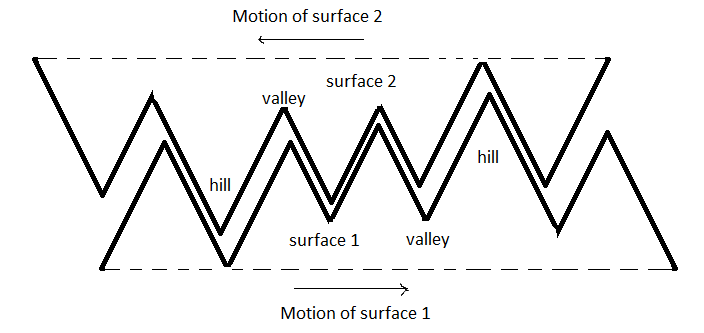
Friction arises due to the interlocking of hills and ________ present in a body.
A. Mountains
B. Holes
C. Valleys
D. None
Answer
599.4k+ views
Hint: Friction is a contact force. It tries to oppose relative motion between two surfaces. It arises when the uneven surfaces of two materials get interlocked with each other due to the interlocking of the tiny bulging out and caving in parts of the uneven surfaces.
Complete step-by-step answer:
The frictional force is a contact surface force which comes into effect whenever there is a tendency, or occurrence of relative motion between two surfaces. Friction is a resistive force and dissipates energy of the bodies in motion through the generation of heat.
The below figure will give a better insight to the mechanism of frictional force.

Even though surfaces of objects may seem smooth at a macroscopic level, at a microscopic level, all surfaces are even and have bulging out parts (hills) and caving in parts (valleys).
When there is relative motion between two surfaces, the hills and valleys get interlocked and try to get joined together. This produces an opposition to the relative motion and is the root cause of the frictional force.
To overcome these forces and continue motion, the interlocking between the hills and the valleys has to be broken for which energy is required. This energy is converted into heat and that is why it is said that friction dissipates energy in the form of heat.
Hence, the correct option is C) Valleys.
Note: The frictional force depends on the coefficient of friction$\left( \mu \right)$. This is a measure of the unevenness and interlocking ability of the surfaces. A surface with a higher coefficient of friction is generally rougher and interlocks with other surfaces to a greater extent, thus producing a stronger frictional force.
Usually the coefficient of friction is between 0 and 1, but can be greater than 1.
Complete step-by-step answer:
The frictional force is a contact surface force which comes into effect whenever there is a tendency, or occurrence of relative motion between two surfaces. Friction is a resistive force and dissipates energy of the bodies in motion through the generation of heat.
The below figure will give a better insight to the mechanism of frictional force.

Even though surfaces of objects may seem smooth at a macroscopic level, at a microscopic level, all surfaces are even and have bulging out parts (hills) and caving in parts (valleys).
When there is relative motion between two surfaces, the hills and valleys get interlocked and try to get joined together. This produces an opposition to the relative motion and is the root cause of the frictional force.
To overcome these forces and continue motion, the interlocking between the hills and the valleys has to be broken for which energy is required. This energy is converted into heat and that is why it is said that friction dissipates energy in the form of heat.
Hence, the correct option is C) Valleys.
Note: The frictional force depends on the coefficient of friction$\left( \mu \right)$. This is a measure of the unevenness and interlocking ability of the surfaces. A surface with a higher coefficient of friction is generally rougher and interlocks with other surfaces to a greater extent, thus producing a stronger frictional force.
Usually the coefficient of friction is between 0 and 1, but can be greater than 1.
Recently Updated Pages
Master Class 11 English: Engaging Questions & Answers for Success

Master Class 11 Biology: Engaging Questions & Answers for Success

Master Class 11 Physics: Engaging Questions & Answers for Success

Master Class 11 Maths: Engaging Questions & Answers for Success

Master Class 11 Accountancy: Engaging Questions & Answers for Success

Class 11 Question and Answer - Your Ultimate Solutions Guide

Trending doubts
One Metric ton is equal to kg A 10000 B 1000 C 100 class 11 physics CBSE

Discuss the various forms of bacteria class 11 biology CBSE

Explain zero factorial class 11 maths CBSE

State the laws of reflection of light

Difference Between Prokaryotic Cells and Eukaryotic Cells

10 examples of friction in our daily life




